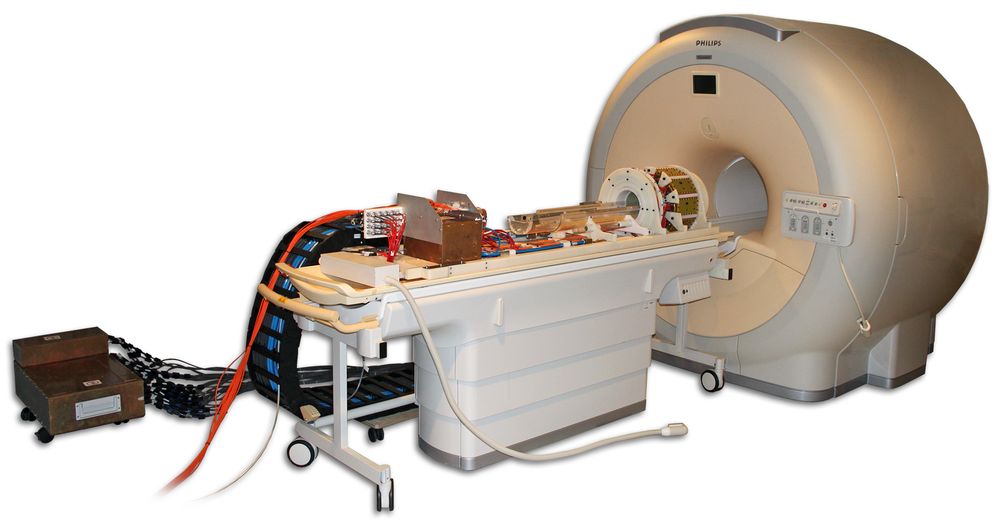Projects
Hyperion IIIWB
Integrated Whole Body System
This wide-bore system is the world’s only PET/MRI scanner with a 70 cm bore diameter. The shape of the bore is exactly like the bore of a standard Philips Ingenia MRI scanner. PET integration is achieved by splitting the gradient coil into two independent halves and placing the PET detectors between them. The MRI scanner and its performance are exactly like in the Elekta Unity MR-Linac radiotherapy system. As such, it is the ideal device for planning the MR-guided treatment sessions. Partners: Philips Healthcare, Futura Composites, and the University Hospital Utrecht.
- 2020 – today
- Partners
- Uniklinik RWTH Aachen (DE)
- Philips Healthcare (NL)
- Futura Composites (NL)
- UMC Utrecht (NL)
- PET field of view (transaxial × axial): 700 mm × 163 mm (currently 700 mm × 50 mm)
- PET sensor technology: Digital SiPMs DPC 3200-22 (PDPC)
- Total amount of crystals: 15,552 (currently installed: 3,456)
- PET detector: 48×48 mm², single-layer, 12×12 LYSO crystals, 4 mm pitch, 19 mm height
- System: 12 Modules with 9 detector blocks each (currently installed: 8 modules with 3 detector blocks each)
- Target MRI Scanner: Philips Ingenia 1.5T with a split gradient coil

- PET Performance
- Energy resolution: 10.9 % FWHM
- Time resolution: 263 ps FWHM
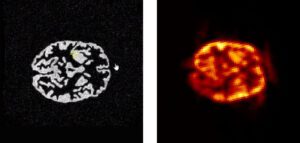
- UMC Utrecht: MRI/PET may better control metastatic tumors
- UMC Utrecht: Part MRI/PET installed. The next step.
- Casper Beijst: Yesterday we had the official handover…

Hyperion IIIM
Breast Cancer Imaging
The PET/RF insert is a research system to study the advantages of a dedicated insert for breast PET/MRI over MRI only and whole-body PET/MRI scanner. It comprises two complete PET detector rings, covering both breasts closely for highest sensitivity and spatial resolution. Following the anatomy of the body, both rings are tilted by 20°. The PET rings can be opened to give access to the breasts for positioning and biopsy. Partners among others: Uniklinik RWTH Aachen, Futura Composites, TU Delft DEMO, Noras MRI Products.
- 2016 – 2022
- Funded by European Union, Horizon 2020 research and innovation programme, grant agreement no. 667211
- Partners
- Uniklinik RWTH Aachen (DE)
- Technische Universiteit Delft / DEMO (NL)
- Futura Composites (NL)
- NORAS MRI Products (DE)
- Philips Electronics (NL)
- Forschungszentrum Jülich (DE)
- Universitätsklinikum Münster (DE)
- Medical University of Vienna (AT)
- European Institute for Biomedical Imaging Research (AT)
- PET field of views:
- Two rings: 2 times 180 mm × 98 mm
- Sternum area is partly covered due to the incliniation of 20° of each ring
- PET sensor technology: digital SiPMs DPC 3200-22 (PDPC)
- Total amount of crystals: 191,800
- Detector: 48×48 mm², 3-layer DOI, 3,425 LSO crystals, 1.33 mm pitch, 15 mm height
- System: Two separate bores with 56 detector blocks arranged on 2 rings
- Target MRI Scanner: Philips Ingenia 1.5T
- MRI RF Coil: 4-Channel Receive Sense Breast Coil
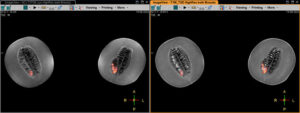
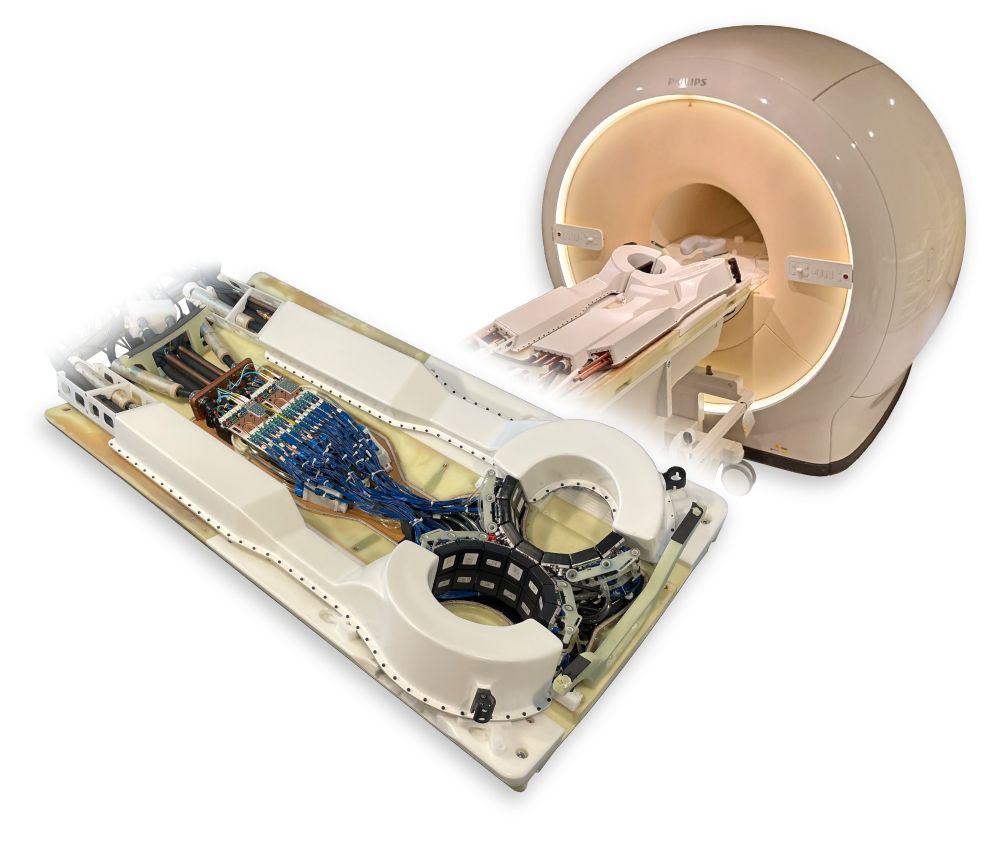
Hyperion IIIBC
PET Detectors in MRI-RF Volume
This technical demonstrator integrates the PET detectors directly into the RF volume of the body coil and not behind its shield. As such, a system with a bore diameter of 65 cm could be achieved. For the integration tests with two line- and three point-sources, two out of 19 detector modules were fully equipped. Partners: Philips Healthcare, Futura Composites, MR Coils, and the university hospital Utrecht.
- 2017 – 2019
- Partners
- Uniklinik RWTH Aachen (DE)
- Philips Healthcare (NL)
- Futura Composites (NL)
- UMC Utrecht (NL)
- MR Coils (NL)
- PET field of view (transaxial × axial): 650 mm × 254 mm
- PET sensor technology: digital SiPMs DPC 3200-22 (PDPC)
- Total amount of crystals in the two modules: 2,880
- PET detector: 48×48 mm², single-layer, 12×12 LYSO crystals, 4 mm pitch, 16 mm height
- System: 2 Modules with 10 detector blocks on opposing positions
- Target MRI Scanner: Philips Ingenia 1.5T
- PET Performance
- Energy resolution: 10.9 % FWHM
- Time resolution using DPC trigger scheme 2 down to 264 ps FWHM
- IEEE NSS/MIC 2019 abstract
Dey, Thomas, et al. “Design and first compatibility studies of PET detector modules for a wide-bore 1.5T PET-MRI system for radiotherapy applications”
- DOI: 10.1016/j.phro.2020.12.002
Branderhorst, Woutjan, et al. “Evaluation of the radiofrequency performance of a wide-bore 1.5 T positron emission tomography/magnetic resonance imaging body coil for radiotherapy planning.” Physics and imaging in radiation oncology 17 (2021): 13-19.
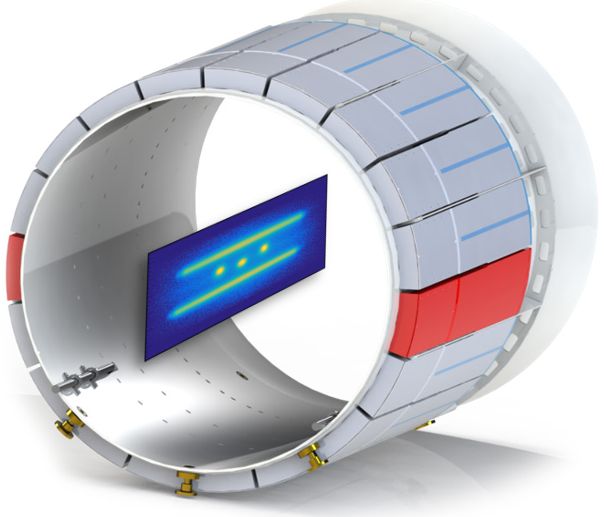
Hyperion IIIB
Neuro PET Insert for Ultra-High-Field MRI
This is an Ultra-High-Field MRI compatible brain-PET insert for Siemens 7T systems. It enables molecular, functional and structural imaging in unprecedented image quality. Partners among others: Forschungszentrum Jülich, Uniklinik RWTH Aachen.
- 2016 – 2021
- A Helmholtz Validation Fund project
- Partners
- Forschungszentrum Jülich GmbH (DE)
- Uniklinik RWTH Aachen (DE)
- Siemens Healthineers (DE)
- Monash University, Victoria, Australia
- Inviscan SA. Strasbourg (FR)
- Affinity Imaging GmbH (DE)
- PET field of view (transaxial × axial): 282 mm × 250 mm
- PET sensor technology: digital SiPMs DPC 3200-22 (PDPC)
- Total amount of crystals: 196,080
- PET detector: 48×48 mm², 3-layer DOI, 1,634 LSO crystals, 2 mm pitch, 24 mm height
- System: 8 Modules with 15 detector blocks each in 5 rings
- Target MRI Scanner: Siemens MAGNETOM Terra 7T
- MRI RF Coil: Custom-made transmit receive head coil

- PET Performance
- Energy resolution: 15 % FWHM (preliminary, to be improved)
- Time resolution: t.b.d ps FWHM
- Sensitivity >12% (simulation)
- Lerche, C., et al. “Development of a UHF-MRI compatible BrainPET insert for neuroscientific applications.” JOURNAL OF CEREBRAL BLOOD FLOW AND METABOLISM. Vol. 42. No. 1_ SUPPL. 2455 TELLER RD, THOUSAND OAKS, CA 91320 USA: SAGE PUBLICATIONS INC, 2022.
- Abstract
DOI:10.1055/s-0040-1708248
Lerche, Christoph, et al. “Design and Simulation of a high-resolution and high-sensitivity BrainPET insert for 7T MRI.” Nuklearmedizin-NuclearMedicine 59.02 (2020): V96.
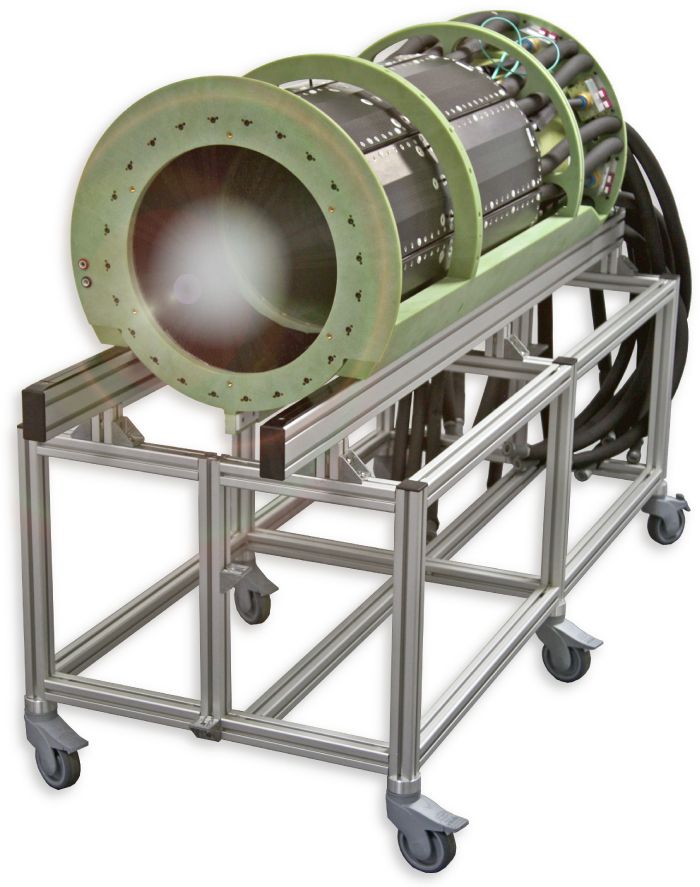
Hyperion IID
World’s first fully digital PET scanner
The PET/MRI insert for preclinical applications is the world’s first fully digital PET scanner and can be docked to a clinical MRI system for simultaneous imaging. It has exchangeable Tx/Rx RF coils for mouse-, rat/rabbit-size, and a multi-nuclei coil for 1H/19F MRI imaging. Hyperion II-D was developed within the Medical Engineering Centre and ForSaTum Project. Partners among others: Uniklinik RWTH Aachen, Philips Research, Kings College London.
- 2011 – 2014
- Funding
- of the overall project by the German federal state North Rhine Westphalia (HighTech.NRW)
- of ForSaTum by the European Union, European Regional Development Fund, Investing In Your Future, grant number z0903ht014g
- of Centre of Excellence in Medical Engineering by the Wellcome Trust and EPSRC, grant number WT 088641/Z/09/Z
- Partners
- Uniklinik RWTH Aachen (DE)
- Philips Technologie GmbH (DE)
- King’s College London (UK)
- Ruhr-Universität Bochum
- AplaGen, PharmedArtis
- Kairos
- ITZ Medicom
- Digital Medics
- invivoContrast
- Aachener Kompetenzzentrum Medizintechnik (AKM)
- PET field of view (transaxial × axial): 209.6 mm × 96.6 mm
- PET sensor technology: digital SiPMs DPC 3200-22 (PDPC)
- Total amount of crystals: 54,000
- PET detector: 32×32 mm², single-layer, 30×30 LYSO crystals, 1 mm pitch, 12 mm height
- System: 10 Modules with 6 detector blocks each in three rings
- Target MRI Scanner: Philips Achieva 3T
- MRI RF Coils:
- Large 1H TX/RX coil (rat- to rabbit-size)
- Small 1H TX/RX coil (mouse-size), FOV (transaxial × axial): 46 mm × 120 mm
- Multi-Nuclei 1H/19F coil (rat- to rabbit-size) (transaxial × axial): 100 mm × 100 mm
- Systems built: 3
- PET Performance
- Energy resolution: 12.7 % FWHM [NEMA]
- Time resolution:
- trigger scheme 1: 256 ps [TOF]
- trigger scheme 3: 546 ps [TOF], 605 ps FWHM [NEMA]
- Spatial resolution: 0.9 mm / 0.73 mm³ FWHM [TMI]
- System sensitivity: 4.1 % [NEMA]
- Maximum activity (NECR curve peak): 35 MBq (limited by raw data transmission)

- [TMI]
DOI: 10.1109/TMI.2015.2427993
Weissler, Bjoern, et al. “A digital preclinical PET/MRI insert and initial results.” IEEE Transactions on Medical Imaging 34.11 (2015): 2258-2270.
- DOI: 10.1088/2057-1976/2/1/015010
Düppenbecker, Peter M., et al. “Development of an MRI-compatible digital SiPM detector stack for simultaneous PET/MRI.” Biomedical Physics & Engineering Express 2.1 (2016): 015010.
- DOI: 10.1088/0031-9155/60/6/2231
Wehner, Jakob, et al. “MR-compatibility assessment of the first preclinical PET-MRI insert equipped with digital silicon photomultipliers.” Physics in Medicine & Biology 60.6 (2015): 2231.
- DOI: 10.1016/j.nima.2013.08.077
Wehner, Jakob, et al. “PET/MRI insert using digital SiPMs: investigation of MR-compatibility.” Nuclear Instruments and Methods in Physics Research Section A: Accelerators, Spectrometers, Detectors and Associated Equipment 734 (2014): 116-121.
- DOI: 10.1088/0031-9155/60/6/2231
Wehner, Jakob, et al. “MR-compatibility assessment of the first preclinical PET-MRI insert equipped with digital silicon photomultipliers.” Physics in Medicine & Biology 60.6 (2015): 2231.
- DOI: 10.1088/0031-9155/61/7/2851
Schug, David, et al. “Initial PET performance evaluation of a preclinical insert for PET/MRI with digital SiPM technology.” Physics in Medicine & Biology 61.7 (2016): 2851.
- [NEMA]
DOI: 10.1088/2057-1976/aae6c2
Hallen, Patrick, et al. “PET performance evaluation of the small-animal Hyperion IID PET/MRI insert based on the NEMA NU-4 standard.” Biomedical physics & engineering express 4.6 (2018): 065027.
- [TOF]
DOI:10.1109/TNS.2017.2654920
Schug, David, et al. “Crystal delay and time walk correction methods for coincidence resolving time improvements of a digital-silicon-photomultiplier-based PET/MRI insert.” IEEE Transactions on Radiation and Plasma Medical Sciences 1.2 (2017): 178-190.
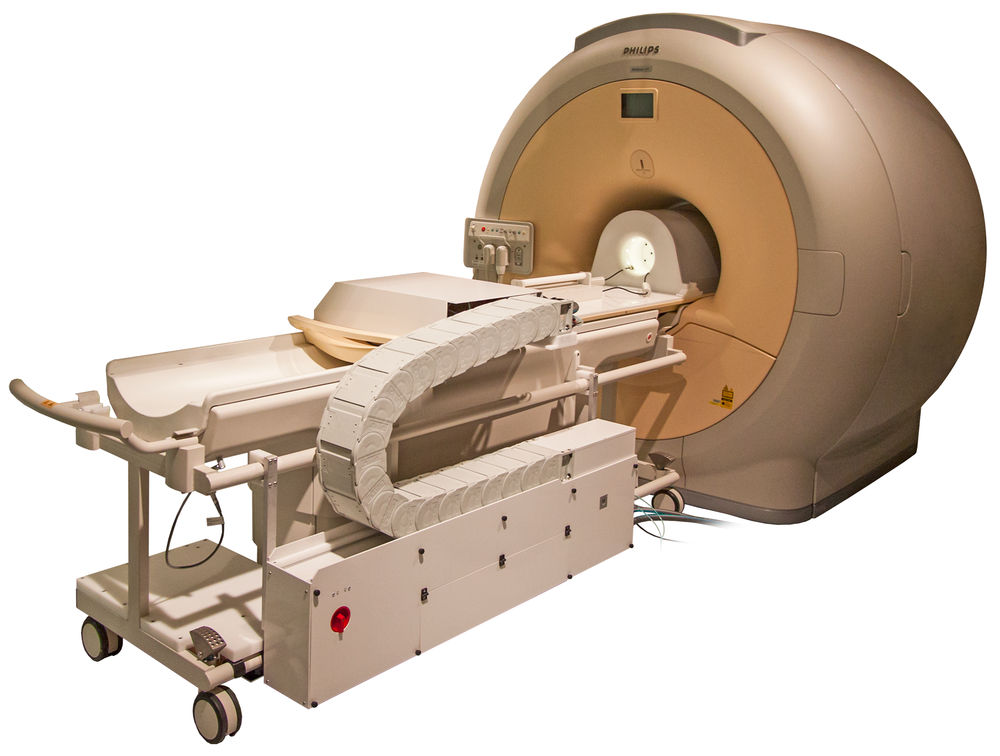
Hyperion IITOF
Time of flight for preclinical-sized systems
- 2010 – 2015
- Funded by European Union FP7, grant agreement no. 241711
- Partners
- Uniklinik RWTH Aachen (DE)
- Philips Research (NL)
- Ruprecht-Karls-Universität Heidelberg (DE)
- TU Delft (NL)
- PET field of view (transaxial × axial): 217.6 mm × 32 mm
- PET sensor technology: digital SiPMs DPC 3200-22 (PDPC)
- Total amount of crystals: 1,280
- PET detector: 32×32 mm², single-layer, 8×8 LYSO crystals, 4 mm pitch, 10 mm height
- System: 10 Modules with 2 detector blocks each in one ring
- Target MRI Scanner: Philips Ingenia 3T
- MRI RF Coil: Large 1H TX/RX coil (rat-to-rabbit size)
- PET Performance
- Energy resolution: 11.4 % FWHM [clinicalSystem]
- Time resolution
- Spatial resolution: 2 mm [clinicalSystem]
- System sensitivity: 0.7 % [clinicalSystem]

- [clinicalSystem]
DOI: 10.1088/0031-9155/60/18/7045
Schug, David, et al. “PET performance and MRI compatibility evaluation of a digital, ToF-capable PET/MRI insert equipped with clinical scintillators.” Physics in Medicine & Biology 60.18 (2015): 7045.
- [TOF]
DOI:10.1109/TNS.2017.2654920
Schug, David, et al. “Crystal delay and time walk correction methods for coincidence resolving time improvements of a digital-silicon-photomultiplier-based PET/MRI insert.” IEEE Transactions on Radiation and Plasma Medical Sciences 1.2 (2017): 178-190.
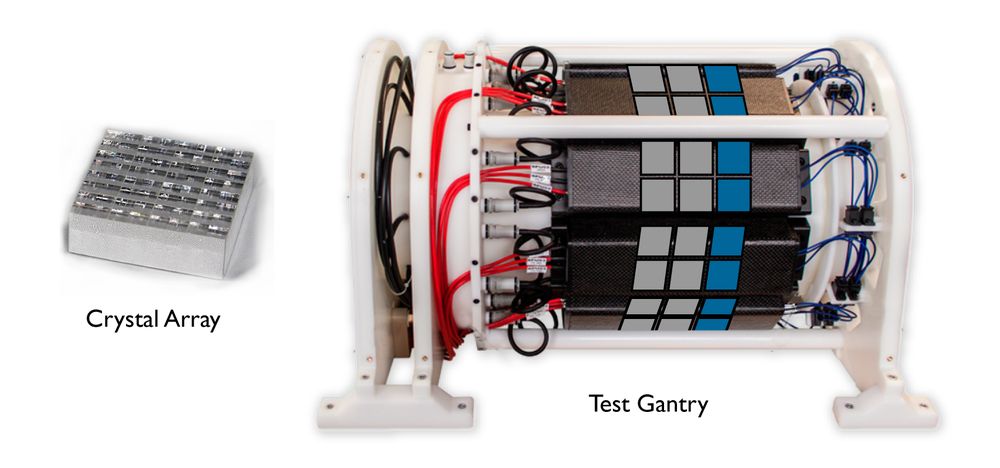
Hyperion I
Preclinical application
The first prototype PET/MRI insert is designed for preclinical applications (rat to rabbit size) on a clinical MRI system. It was developed within the HYPERImage project. Partners among others: Philips Research, FBK, University of Heidelberg, Ghent University, Kings College London, iMinds.
- 2008 – 2011
- Funded by European Union FP7, grant agreement no. 201651
- Partners
- Philips Technologie GmbH (DE)
- King’s College London (UK)
- Centro Nacional De Investigaciones Cardiovasculares Carlos III (F.S.P.) (ES)
- Stichting Het Nederlands Kanker Instituut-Antoni van Leeuwenhoek Ziekenhuis (NL)
- Universitätsklinikum Hamburg-Eppendorf (DE)
- Ruprecht-Karls-Universität Heidelberg (DE)
- iMinds VZW (BE)
- Fondazione Bruna Kessler (IT)
- PET field of view: 160 mm transaxial x 30 mm axial (94.1 mm prepared)
- PET sensor technology: Analog SiPMs (FBK) with PETA2 ASIC (University of Heidelberg)
- Total amount of crystals: 9,680
- PET Detector: 30×30 mm², single-layer, 22×22 LYSO crystals, 1.3 mm pitch, 10 mm height
- PET System: 10 Modules with 2 detector blocks each in one ring
- Target MRI Scanner: Philips Achieva 3T
- MRI RF Coil: Permanently mounted RF transmit/receive coil (16-rod birdcage resonator)
- FOV (transaxial × axial): 160 mm × 160 mm
- PET Performance
- Energy resolution: 29.7 % FWHM
- Time resolution: 2.5 ns FWHM
- Energy resolution: 29.7 % FWHM
- Spatial resolution: 1.7 mm / 1.8 mm3 FWHM
- System sensitivity: 0.6 %
- Maximum activity: 35 MBq

- DOI:10.1088/0031-9155/59/17/5119
Weissler, Bjoern, et al. “MR compatibility aspects of a silicon photomultiplier-based PET/RF insert with integrated digitisation.” Physics in Medicine & Biology 59.17 (2014): 5119.
- DOI:10.1109/TNS.2015.2392560
Mackewn, Jane E., et al. “PET performance evaluation of a pre-clinical SiPM-based MR-compatible PET scanner.” IEEE Transactions on nuclear science 62.3 (2015): 784-790.
- DOI:10.1109/NSSMIC.2013.6829111
Soultanidis, Georgios M., et al. “Demonstration of motion correction for PET-MR with PVA cryogel phantoms.” 2013 IEEE Nuclear Science Symposium and Medical Imaging Conference (2013 NSS/MIC). IEEE, 2013
